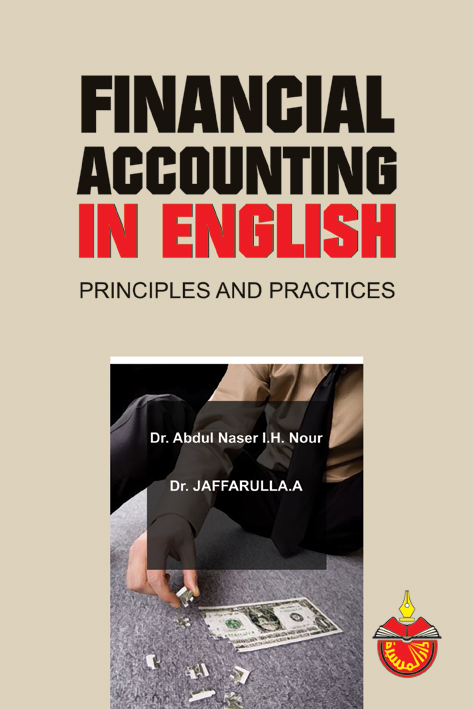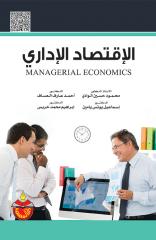- اسم الكتاب
المحاسبة المالية باللغة الانجليزية FINANCIAL ACCOUNTING IN ENGLISH


المحاسبة المالية باللغة الانجليزية FINANCIAL ACCOUNTING IN ENGLISH
We are happy to introduce "Financial Accounting Principles and Practices in English." The Fourth edition of this book has been revided, updated and enticed in various chapters, where needful alterations were necessary to provide more linkage and integration. It is predominantly an age of Accounting, Today there is hardly any area of life into which accounting has not found its way. More and more government departments, national and international institutions have realized the significance of accounting.
Accounting which is one of the branches of commerce, is the language of business. It records the business transactions taking place during the accounting period and communicates the results of the transactions to various parties, namely proprietors, creditors and potential investors. Proprietors of a business are interested in the wellbeing of business. The present creditors want to know the solvency of the business and the potential investors are keen to know the earning potential of the business. In view of the utility of accounting statements to various interested parties, it is necessary to recognize the urgency of a scientific approach to the recording of business transactions and communicating the results to various parties. Keeping this in view, an attempt has been made in the book to present the methods of preparation of accounts in a lucid manner to cater to the best needs of the readers. The main intention of this book is to present the subject- matter in such a manner that a student who has no prior knowledge of the subject of Accountancy can understand the scientific approach without any difficulty.
We have kept in mind he level of the standard of English among the students and have treated all the topics in a simple language and lucid style, which will enable them to grasp the essence of the subject.
Though there is no dearth of books on this subject in the market, an employee with severe constraint of time still gropes in the dark in the absence of a fruitful and proper guidance. It is hoped that this book will also cater to the needs of the employees. In this book, the basic concepts have been explained thoroughly followed by a good number of suitable but graded illustrations. Review questions and practical problems have also been given at the end of each chapter to provide the students and employees with an opportunity to test their ability.
Inspite of our best efforts, in the predation of this book, several errors of commissions and omissions may have crept in. In a book on a technical subject, such as the present one, it is futile to expect that printer's devil has not entered in. We shall be grateful if the mistakes, deficiencies and suggestions are brought to our knowledge by careful and benevolent readers for further improvement of this book.
1. ACCOUNTING – INTRODUCTION:
Introduction
Definition of Accounting
The users of Accounting information
Definition of Book – Keeping
Features of Book – Keeping
Objects of Book – Keeping
Importance of Book – Keeping
Utility of Book – Keeping
The Distinction between Book – Keeping and Accountancy
Functions of Accounting
Classification of Accounting
Limitation of Accounting
Accounting Principles, Concepts and Conventions
Test Questions
2. ACCOUNING TRANSACTION, RECORDING, POSTING AND PREPARATION OF TRIAL BALANCE:
Double Entry Book – Keeping
Advantages of Double Entry System
Disadvantages of Double Entry System
Classifications of Accounts
Rules of Journalisation
Balance Sheet Equation
Illustrations
Accounting Cycle and Books of Accounts
Source Documents
Books of Original Entry
The Journal
Utility of Journal
Journalising
Illustrations
Types of Entries
Illustrations
The Ledger
Balancing The Ledger Account
Illustrations
Debit Balance
Credit Balance
Illustrations
Trail Balance
Nature of Balances of Different Ledger Accounts
Illustration
Book – Keeping and Accounting Terms
Test Questions
3. SUBSIDIRY BOOKS:
The Cash Book
Cash Book with Receipts and Payments Column
Illustration
Tow Column Cash Book
Illustration
Triple Column Cash Book
Illustration
The Perry Cash Book
Illustration
Credit Books
Discount
Trade Discount
Cash Discount
Differences between Trade Discount and Cash Discount
Purchases Book
Illustration
Sales Book
Illustration
Purchases Returns Book
Illustration
Sales Returns Book
Illustration
Bills Receivable Book
Illustration
Bills Payable Book
Illustration
Test Questions
4. ACCOUNTING FOR ASSETE AND LIABILITIES:
Meaning Cost of Assets
Determining Cost of Assets
Current Assets
Classifications of Current Assets
Cash
Cash Shortage and Overage
Band Reconciliation
Reconciliation of Ledger Cash Account and Band Account
Reasons of Disagreement
Methods of Preparation of Bank Reconciliation Statement
Merchandising Transactions
Income Measurement for a merchandising company
Revenue From Sales
Cost of Goods Sold
Quantity Discount
Test Questions
5. DEPRECIATION:
MEANIN
CAUSES of Depreciation
Need for providing Depreciation
Straight line Method
Illustrations
The Diminishing Balance Method
Accumulated Depreciation Investment Method
Revaluation Method
Machine Hour Rate Method
Depreciatioin Accounting
Traditional (Direct) Method
Modern (Indirect) Method
Disposal of Fixed Assets
Sale of Fixed Assets
Exchange of Fixed Assets
Test Questions
6. CAPITAL AND REVENUE EXPENDITURE:
Capital and Revenue Expenditure
Distinquish between Capital Expenditure and Revenue Expenditure
Rules for Determining Capital Expenditures
Rules for Determining Revenue Expenditures
Outstanding Expenses or Accrued Expenses
Prepaid Expenses or Expenses paid in advance
Outstanding or Accrued Income
Incomes Received in Advance
Test Questions
7. ACCOUNTING FOR COMMERICIAL PAPERS:
MEANING OF Commercial Papers
Cheques
Definition of Bill of Exchange
Parties of a Bill of Exchange
Promissory Note
Accounting Entries of Bills of Exchange and Promissory Note
Test Questions
8. FINANCIAL NOTES PAPERS:
Investment in Securities
Classification of Securities
Accounting treatment for Marketable Securities
Sale of Securities
Sale of Shares
Securities Valuation and presentation on Balance sheet
Test Questions
9. TRIA BALANVE, ERRORS AND THEIR RECTIFCATION:
MEANING of Trial Balance
Objects of preparing Trail Balance
Main Characteristics and uses of a Trial Balance
Limitations of a Trial Balance
Errors
Classification of Errors
How to Correct Errors
Suspense Account
Test Questions
10. FINANCIAL STATEMENTS AND CLOSING ACCOUNTS:
Object of a business
Final Accounts
Trading Account
Manufacturing Account
The profit and Loss Account
Income Statement
Difference between Trading and Profit and Loss Acount
Balance sheet
Balance sheet as per American system
Difference between Trading and profit and Loss Account
Final Account- Adjustments
Adjustment for Bad debt
Adjustment for Provision for Doubtful Debts
Adjustment for Bad Debts, New Bad Debts, New Reserve and old Reserve
Provision for Discount on Debtors
Adjustment for Interest on Capital
Adjustment for Interest on on Drawing
Test Questions
The statement of cash flow
11. COMMERCIAL BUSINESS:
Forms of Business organisation
Commercial Business Firms
Commercial Activity
Shops And Stores
Test Questions
12. COMMERCIAL CORRESPONDENCE:
How to evaluate your letters
Parts of the Letter
Auxiliary parts of the letter
Some Rules for good Writing
Commercial Letters
Letters to Suppliers and Reply
Sales Related Enquiry
Writing Orders
Letter Confirming an order
Acknowledgment of order
Execution of order
Request for Payment
Test Questions
Meanings of Accounting
Terminologies in Arabic
Books Referred









